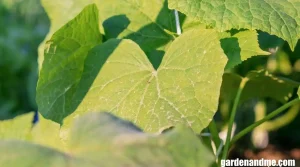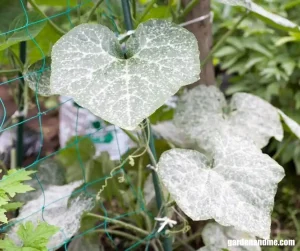When growing cucumbers, seeing your cucumber plant leaves turn white can be pretty alarming. This sudden color change can be a sign of a problem and may indicate that your cucumber plant is suffering from a condition known as powdery mildew. Understanding the causes and finding effective remedies for this issue can help you prevent further damage and ensure the health of your cucumber plants.

Signs of powdery mildew on cucumber leaves
The abnormal symptoms of cucumber leaves can be detected easily by the eyes. Overall, white leaves spots or patches on the surface of the cucumber leaves. In advanced stages, we call powdery mildew, may spread to the entire leaf of the plant, even the stems and fruit. If the plants are left untreated, widespread or severe infections can inhibit the growth and development of the cucumber plants.
The leaves can also become distorted or curl inward. The color may turn yellow or brown. When we touch the infected leaves, they may drop prematurely. Also, the powdery substance and dust may rub off easily. The leaves may appear discolored or have black or brown patches under the granular layer.
The reason why cucumber leaves turn white
There are several possible causes for your cucumber leaves to turn white spots:
Powdery mildew spores: This common fungal disease can appear as white fine spots on the leaves. It thrives in warm and humid conditions.
Downy mildew: Another fungus disease that causes white spots, though these spots are usually angular in shape and can turn yellow or brown over time.
Sunburn: If the cucumber plants are exposed to intense sunlight for prolonged periods, it can result in white mold on the leaves due to sunburn.
Chemical damage: Exposure to certain chemicals or pesticides can cause the leaves to appear white spots. This can happen if the plants are exposed to excessive amounts or when chemicals are applied during hot weather.
Nutritional deficiencies: Deficiencies in essential nutrients like zinc, manganese, or magnesium can cause white spots on cucumber leaves.
Insect damage: Cucumber leaves also can turn white due to certain insects, such as spider mites or aphids, resulting in white spots.
Environmental stress: Environmental factors like high temperatures, low humidity, or drought can cause your cucumber has white spots.
Transplant shock: Relocating the plants to different areas can also make them startled, resulting in the leaves becoming yellow or falling off.
It is essential to accurately identify the cause of the white spots on cucumber leaves to implement appropriate treatment or preventive measures. Consulting with a local agricultural extension office or a professional gardener can help diagnose the issue and provide guidance on how to address it.
Ways to treat white cucumber leaves
To prevent powdery mildew on cucumber, we can use natural remedies to get rid of the white powder by regularly applying fungicide to the entire plant to avoid white powder on leaves.
We also can use neem oil as a measure for powdery mildew infection. Another recipe is mixing one tablespoon of baking soda and water, then spraying this mixture on the leaves and stem sheaths. Make sure we have to provide proper watering techniques to prevent the mildew.
The most important thing is the leaves getting enough sunlight – it is crucial for cucumber plants’ healthy growth and productivity. Insufficient sunlight can result in weak plants, reduced fruit production, and various other issues. Therefore, to provide enough sunlight for cucumber plants, follow these steps:
1. Choose a suitable location: Select a spot in your garden that receives at least 6-8 hours of direct sunlight daily. Cucumbers thrive in total sun exposure.
2. Clear the area: Remove any weeds, grass, or debris blocking sunlight from reaching the cucumber plants.
3. Consider the orientation: Position the cucumber plants in a north-to-south direction to ensure they receive maximum sunlight throughout the day.
4. Avoid shade: Trim or remove nearby trees, shrubs, or structures that may cast shadows on the cucumber plants during the day. They need uninterrupted exposure to full sun.
5. Use reflective surfaces: Place reflective materials around the cucumber plants, such as aluminum foil or white plastic mulch. These surfaces reflect more light onto the plants, enhancing the sunlight they receive.
6. Prune or train the plants: If your cucumber plants are sprawling or bushy, consider pruning them to enhance sunlight penetration. You can also use trellises or stakes to train the vines upward, allowing for more efficient light absorption.
7. Monitor and rotate: Monitor the sun’s movement and adjust if necessary. If your cucumber plants are in containers, consider turning them periodically to ensure all sides receive equal sunlight.
How to grow cucumber plants
Here are some steps to help you grow cucumber plants:
1. Choose the right variety: Select a cucumber suitable for your climate and growing conditions. You can consider bush cucumbers, which require less space, or vine cucumbers, which need support to grow and spread to sprawl.
2. Prepare the soil: Cucumbers prefer well-drained soil rich in organic matter. Prepare the ground by loosening it with a garden fork or tiller. Remove any weeds and add compost or aged manure to enrich the soil.
3. Planting: Wait until all the frost has passed before planting cucumber seeds or seedlings. Sow the seeds directly into the ground, 1 inch deep and about 6-12 inches apart if you are planting bush varieties or 1-3 feet apart if you are planting vine varieties. Ensure to provide a trellis, stakes, or a fence for the vine cultivars to climb.
4. Watering: Cucumbers need regular watering to grow correctly. Keep the leaves and surrounding soil consistently moist but not soggy. Water deeply, especially during hot and dry periods, and avoid overhead watering to prevent the growth of foliar diseases. One gallon of water is recommended for use.
5. Fertilize: Apply a balanced vegetable fertilizer or compost every two to three weeks to provide the necessary nutrients for the roots of the plants. Follow the instructions on the fertilizer package for the correct amount to use.
6. Pest and disease management: Monitor your cucumber plants regularly for any signs of pests or diseases. Common problems include cucumber beetles, aphids, and powdery mildew. Use organic pest control methods such as insecticidal soap, neem oil, or beneficial insects to manage pest problems.
7. Harvesting: Harvest cucumbers when they are firm and bright in color, usually around 50-70 days after planting. Pick them before they become overly ripe or large, as they may become bitter or harsh.
By following these steps, you should be able to grow healthy plants and enjoy a bountiful harvest successfully.

